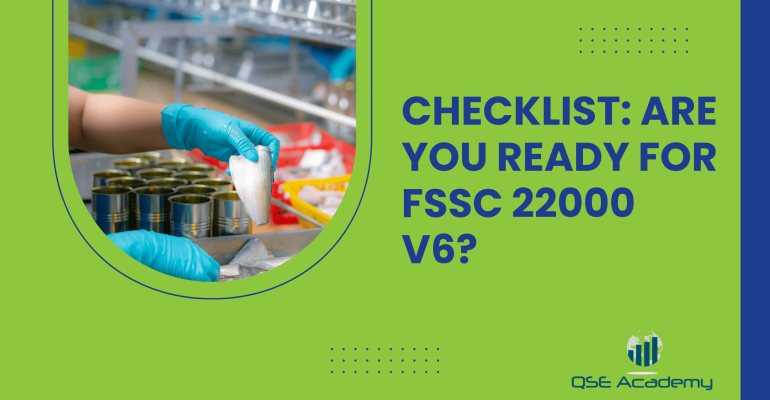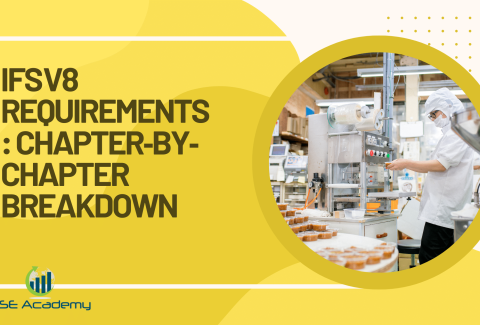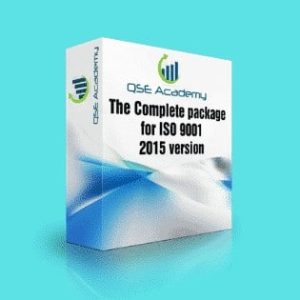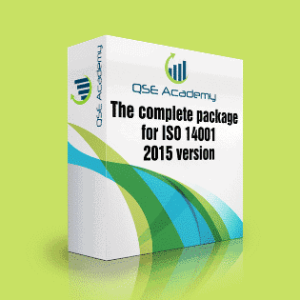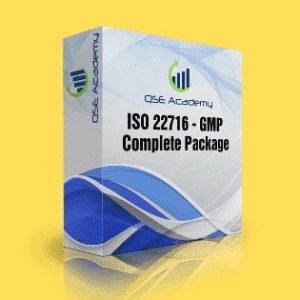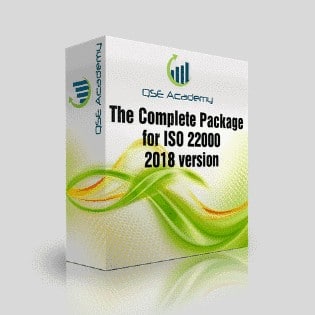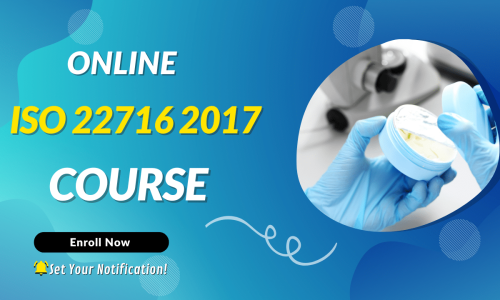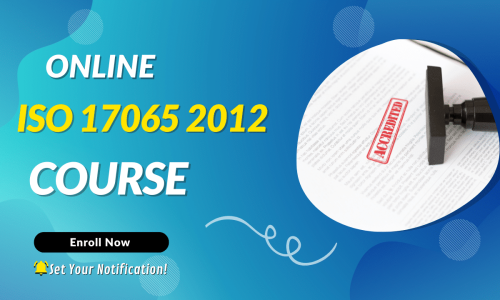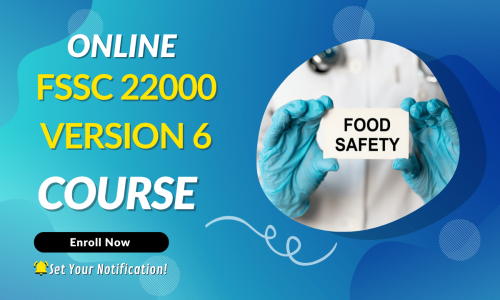Checklist: Are You Ready for FSSC 22000 V6?
Last Updated on October 13, 2025 by Hafsa J.
Checklist: Are You Ready for FSSC 22000 V6?
I’ll be honest—I’ve worked with a lot of companies who thought they were ready for a standard update… until we went down the checklist. And that’s when the gaps showed up.
Not because they weren’t doing the work. But because they assumed updated documents or one training session meant they were good to go. The truth is, FSSC 22000 Version 6 is deeper than a few SOP changes. It’s about culture, validation, waste tracking, and a whole new level of accountability.
The good news? You don’t have to guess. A solid checklist can tell you exactly where you stand—and what’s still missing. In fact, I’ve used this same kind of list to help dozens of clients transition smoothly, pass their audits, and avoid last-minute chaos.
In this post, I’ll walk you through a practical, real-world checklist you can use with your team right now. Whether you’re halfway through the transition or just getting started, it’ll help you spot the gaps early—and fix them before audit day.
Ready to find out if you’re truly prepared for Version 6? Let’s dive in.
Leadership & Culture
Let’s start with the foundation. Version 6 isn’t just about procedures—it’s about people. And if leadership and culture aren’t dialed in, the rest won’t hold.
-
Leadership understands what Version 6 requires and actively supports the transition
-
You have a defined food safety and quality culture plan—not just a vague intention
-
There’s documented evidence of culture-building activities (e.g. surveys, feedback, behavior observations)
-
Supervisors and managers can clearly explain how they support a positive food safety culture
Why this matters:
Auditors want to see that culture is real—not just a poster on the wall. If your team can’t describe it or show how it’s being measured, it’s going to raise questions.
HACCP and Risk Management
This is where many teams assume they’re in the clear—until they dig in and realize their hazard analysis hasn’t been touched in years.
-
HACCP plan has been reviewed and updated based on Codex 2020 revisions
-
Hazards are clearly categorized (chemical, physical, biological, allergenic)
-
CCPs and control measures have been validated and documented
-
Risk assessments reflect any operational changes tied to Version 6
Quick reminder:
If your team is still using the same hazard decision tree from 2017, it’s probably due for an update.
Procedures & Documentation
Here’s where most of the visible work happens—and where you might think, “we’re good.” But are your procedures really aligned with the new focus areas?
-
SOPs and PRPs are updated to reflect Version 6 clauses
-
There’s a documented strategy for reducing food loss and waste
-
Sanitation procedures include validation steps—not just cleaning schedules
-
New or modified equipment has been validated post-installation
-
Allergen control measures have been reassessed and strengthened
Tip from the field:
Auditors often ask for real examples of validation—swab results, test runs, trend data. Be ready to show it, not just talk about it.
Team Training
If your team doesn’t understand the changes—or how they affect their role—your audit is going to get bumpy. Training is where systems either click… or collapse.
-
You’ve updated your training matrix to reflect Version 6 topics
-
Every role has received targeted, relevant training (not one-size-fits-all)
-
Operators, line staff, and supervisors can explain key changes related to their work
-
Food safety culture, waste awareness, allergen controls, and validation procedures are included in training content
-
Training is documented: sign-in sheets, summaries, objectives, and (if possible) comprehension checks
Pro insight:
The best-prepared teams I’ve worked with didn’t just deliver training—they followed up with mini-audits or simple Q&As to make sure it stuck.
Internal Audits & Monitoring
You can’t fix what you don’t catch. And if your internal audits still follow a Version 5.1 checklist, you’re flying blind.
-
Internal audit schedule includes all the new Version 6 requirements
-
You’ve completed at least one mock audit or transition review
-
Your environmental monitoring program reflects updated risk assessments
-
You’re collecting and trending food safety culture and waste management data
-
Allergen control checks, swab results, and validation records are being reviewed regularly
What auditors look for:
They want to see that you’re not just ticking boxes—but that your audits are catching issues, driving improvement, and covering the right scope.
Certification Planning
This is the part that too many teams overlook—until it’s too late. Planning your audit is just as important as planning your procedures.
-
You’ve scheduled your Version 6 transition audit with your certification body
-
Your auditor knows you’re transitioning and has confirmed the scope
-
All required documentation (gap assessment, training records, validation logs, etc.) is compiled and accessible
-
You’ve completed a final internal readiness check—and addressed any gaps
-
You’ve allowed enough time before your certificate expiry to correct findings if needed
Final reminder:
After March 31, 2025, Version 5.1 certificates expire. If you don’t pass your Version 6 audit before then, you’ll need to go through a full re-certification.
Pro Tips from the Field
Tip 1: Don’t just “update”—re-engage
Instead of quietly revising documents in the background, involve your team. Use toolbox talks, mini-trainings, or team huddles to explain why changes were made. It turns compliance into shared ownership.
Tip 2: Start tracking waste and culture now
Auditors want to see trends, not just plans. The earlier you start collecting real data—on food waste or cultural behaviors—the more confident you’ll be when audit day comes.
Tip 3: Use the checklist in a team meeting
Assign each section of this checklist to a different department lead. It turns the transition into a team project instead of a QA burden—and gets you buy-in from the start.
Tip 4: Treat your internal audit like a dress rehearsal
Don’t go easy on yourself. Ask the hard questions. Try to catch what the auditor will. The more honest your self-assessment is, the fewer surprises you’ll face later.
Tip 5: Keep a live “readiness folder”
Have one shared place (physical or digital) where you drop all Version 6-related evidence: gap assessments, training records, waste logs, validation reports. It saves time and makes audit prep painless.
Common Mistakes That Could Derail Your Transition
Relying on updated documents alone
Updating your SOPs is important—but if your staff hasn’t been trained on them, or can’t explain the changes, auditors will flag it. Version 6 is all about implementation, not just paperwork.
Underestimating the time required to collect evidence
Culture metrics and waste tracking can’t be created overnight. If you wait too long to start logging, you’ll end up with gaps—or worse, last-minute data that looks rushed and unconvincing.
Skipping validation steps
I’ve seen teams update procedures but forget to validate them—especially around cleaning, new equipment, and control measures. Without proof that your updates work, you’re taking a big audit risk.
Not involving the full team
This isn’t just a QA task. Ops, maintenance, sanitation, HR—everyone plays a role in Version 6 readiness. If you don’t involve them early, important pieces will get missed.
Delaying audit scheduling
Certification bodies are busy, and slots fill up fast. If you wait too long to schedule your Version 6 audit, you could risk missing the transition deadline—and that means certificate expiry.
Frequently Asked Questions
Q: Is it enough to just update our documents and wait for the audit?
No. Auditors want to see that your updates have been rolled out, understood, and embedded into your day-to-day operations. That means evidence, training records, and staff interviews—not just fresh PDFs.
Q: What if we’re late getting started—can we still make the deadline?
Yes, but you’ll need to move fast. Start with a focused gap assessment, prioritize the most time-sensitive updates (like culture and waste tracking), and schedule your audit as soon as possible.
Q: Do frontline staff really need to know about Version 6?
Absolutely. They don’t need to memorize clauses, but they do need to understand what’s changed in their tasks—and be able to talk about it during the audit. Even basic awareness goes a long way.
Q: How much evidence do we need for food safety culture?
Auditors aren’t expecting perfection, but they are expecting action. That could include surveys, feedback loops, leadership communications, meeting notes, or examples of how you’ve addressed team behavior. It needs to be visible and documented.
Q: Can we use this checklist as part of our internal audit?
Yes—many teams do. In fact, using it in your internal audit is a great way to show the auditor that you’re actively reviewing your transition progress in a structured way.
Don’t Guess. Know You’re Ready.
If there’s one thing I’ve learned helping companies through FSSC transitions, it’s this: the difference between a smooth audit and a stressful one often comes down to one thing—preparation.
This checklist isn’t just a formality. It’s a mirror. It shows you what’s working, what’s missing, and where to focus before an auditor points it out. And the best time to do this? Right now—while you still have time to fix what’s fixable.
Whether you’re just getting started or deep in the transition, this list gives you a clear, structured way to move forward with confidence.
Want a little extra support?
Download our complete FSSC 22000 Version 6 Readiness Checklist—with a built-in scoring tool you can use in your next team meeting.
Or book a session at QSEAcademy.com, and we’ll walk through your transition progress together.
You don’t need to tackle this alone. And you definitely don’t need to wait until the audit to find out what’s missing.
Let’s make sure you’re truly ready.
Whether it’s ISO 9001, ISO 22000, or the cosmetics-focused ISO 22716, I’ve spent my career I’m not here to call myself an expert—I prefer “enthusiast” because I truly love what I do. When I’m not writing about standards, you’ll probably find me playing Piano 🎹, connecting with people, or diving into my next big project💫. I’m an engineer specialized in the food and agricultural industry
make ISO standards less intimidating and more approachable for everyone.
turning complex jargon into clear, actionable steps that businesses can actually use.
There’s something incredibly rewarding about helping people navigate food safety and quality management systems
in a way that feels simple, practical, and even enjoyable.
I have a Master’s in QHSE management and over 12 years of experience as a Quality Manager
I’ve helped more than 15 companies implement ISO 9001, ISO 22000, ISO 22716, GMP, and other standards
My clients include food producers, cosmetics manufacturers, laboratories, and service companies
I believe quality systems should be simple, useful, and efficient.

